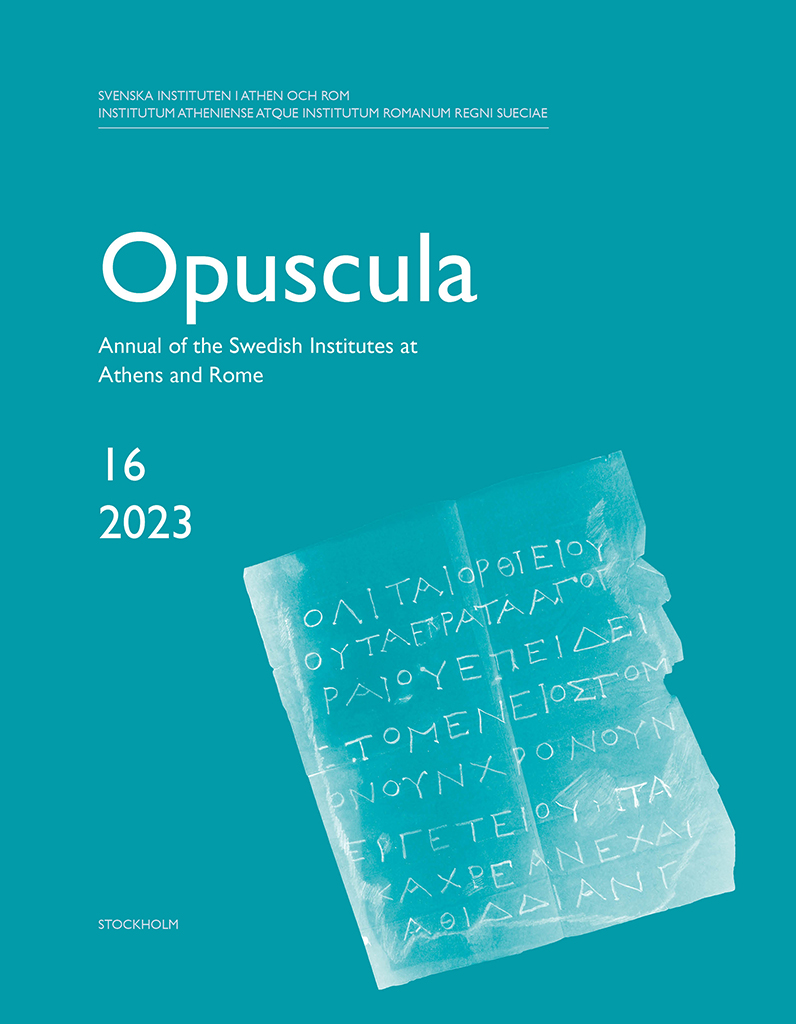Opuscula is published by the Swedish Institutes at Athens and Rome, with the aid of a grant from the Swedish Research Council. Distributed by Eddy.se AB. View journal at ERIH PLUS. All content available with open access. The humans of ancient Hermione. The necropolis in the light of bioarchaeology By Anna Tornberg Abstract Bioarchaeology has the potential to substantially inform about ancient lifeways through osteological analyses of the remains of the once-living individuals. This article provides insights of the demography and health of the people of ancient Hermione (Geometric–Roman period). A minimum number of 85 individuals from the Hermione necropolis was osteologically analysed. Although the analysis was limited by taphonomic processes and the long period of use of the necropolis, the results point towards a population affected by urban hazards, such as infections, high child mortality, and, possibly, decreased opportunity to survive into senescence. Further, stunted growth, evidence of general stress primarily in the juvenile skeletal assemblage, and a possible case of child abuse informs of the hardships experienced by children in ancient Hermione. The osteological analysis also confirms that the two individuals buried in the “Warrior Tomb” were of both sexes. The skeletal remains were unfortunately too poorly preserved…
Opuscula is published by the Swedish Institutes at Athens and Rome, with the aid of a grant from the Swedish Research Council. Distributed by Eddy.se AB. View journal at ERIH PLUS. All content available with open access. Life and death in ancient Hermione. Excavations in the necropolis By Angeliki Kossyva (Ephorate of Antiquities of the Argolid, Greece) Abstract The wealth of ancient Hermione is no longer visible: continuous habitation from c. 3000 BC down to the present day has obliterated most traces. Important information on the social organization and economy of Hermione can however be drawn from the tombs that have been unearthed. A large cemetery was discovered in the early 20th century just outside the city gate, stretching along the road leading to ancient Mases and in continuous use for a period of 1,500 years. It covers an area of 1.5 km east–west along the modern Hermione–Kranidi rural road, taking in the terrain to either side to a width of 160 m and extending south to Pron Hill and north to a patch of level ground some 60 m wide. In this article we focus on cemetery finds unearthed in the area south of the present-day Gymnasium-Lykeion school of…
Opuscula is published by the Swedish Institutes at Athens and Rome, with the aid of a grant from the Swedish Research Council. Distributed by Eddy.se AB. View journal at ERIH PLUS. All content available with open access. An ancient cityscape and its people: A study of ancient Hermione. Introductory remarks on historical sources and visible remains, archaeological research and prospects By Alcestis Papadimitriou (Ephorate of Antiquities of Argolid, Greece) Abstract This article provides a brief introduction to the area of the Hermionid and the research that has been carried out in ancient Hermione. The main textual sources are presented, as are the still-visible archaeological remains and the results of important rescue excavations. The contribution outlines the scientific framework of the project that has generated the five articles that follow, and closes with an agenda for future development for the exploration and preservation of ancient Hermione. Bibliographical information Alcestis Papadimitriou, ’An ancient cityscape and its people: A study of ancient Hermione. Introductory remarks on historical sources and visible remains, archaeological research and prospects’, Opuscula. Annual of the Swedish Institutes at Athens and Rome (OpAthRom) 14, Stockholm 2021, 65-76. ISSN: 2000-0898. ISBN: 978-91-977799-3-7. Softcover, 478 pages. https://doi.org/10.30549/opathrom-14-05 Hermione. A Greek cityscape and its people The…


